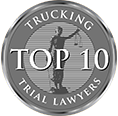Explosive Liability: Handling Hazardous Material Trucking Cases
Link to the Article: Gideon_Asen MLR 2023.08.10 – Explosive Liability – Handling HazMat Trucking Cases
Due to federal regulations and state standards governing the operation of commercial motor vehicles, litigating a truck accident case is more complicated than litigating a run-of-the-mill motor vehicle accident. Where the tractor-trailer in question is hauling hazardous materials, however, additional standards apply that govern the driver’s—and therefore, the motor carrier’s and shipper’s—conduct. By understanding the contents and interrelationship of these standards, attorneys can more effectively establish liability in HazMat truck accident cases and thus achieve better results on their clients’ behalf.
DEFINING “HAZARDOUS MATERIAL”
Pursuant to the Federal Motor Carrier Safety Act, a hazardous material is defined as “[a]ny material that is capable of posing an unreasonable risk to health, safety, and property when transported in commerce.” 49 C.F.R. § 171.8 (2023). In order to simplify the many handling and transport requirements, the United States Department of Transportation has established nine different “classes” of hazardous materials. See 49 C.F.R. § 173 (2023). These classes include “Explosives” (Class 1), “Gases” (Class 2), “Flammable Liquids” (Class 3), “Flammable Solids” (Class 4), “Oxidizers and Organic Peroxides” (Class 5), “Poisonous or Toxic Materials” (Class 6), “Radioactive Materials” (Class 7), “Corrosives” (Class 8), and “Miscellaneous Hazardous Materials” (Class 9). See id.
To be considered a hazardous material requiring additional HazMat transportation, two criteria must apply: (1) the materials must appear on the Environmental Protection Agency’s “List of Hazardous Substances” provided in Appendix A to 49 C.F.R. § 172.101; and (2) the amount of the material transported in one package must meet or exceed the reportable quantity (“RQ”) listed in Table 1 to the same Appendix. Hazardous materials must be identified on shipping documents and packaging identifying the appropriate RQ for transportation. Thus, if the product to be shipped is considered a “Hazardous Material,” then the Hazardous Materials Table set forth in Section 172.101 sets forth the applicable packaging and labeling requirements.
THE DRIVER’S RESPONSIBILITIES
In many ways, the Hazardous Material Table is the most important part of the HazMat transportation process, as it enables the appropriate party to fill out shipping documents and select the necessary labeling, marking, and placarding necessary. Indeed, pursuant to the Federal Motor Carrier Safety Act, all commercial motor vehicle operators must have knowledge of:
- What constitutes hazardous material requiring an endorsement to support;
- Classes of hazardous materials;
- Labeling/placarding requirements; and
- Need for specialized training as a prerequisite to receiving the endorsement and transporting hazardous cargoes.
49 C.F.R. § 383.111(18)(i)-(iv) (2023).
Although the shipper is responsible for packaging and classifying the Hazardous Material, as well as preparing the necessary paperwork, the driver is required to know the hazards of the materials being transported and be able to identify any mistakes the shipper has made. As the CDL manual makes clear, HazMat rules exist to “contain the product, communicate the risk [and] ensure safe drivers and equipment.” CDL Manual § 2.23.2.
To that end, the CDL Manual requires drivers of Tanker Trucks to follow safe driving rules, including, inter alia: (a) starting, slowing down, and stopping smoothly (CDL Manual § 8.3.1, “Drive Smoothly”); (b) “keep[ing] a steady pressure on the brakes” and “break[ing] far in advance of a stop and increase[ing] your following distance” (CDL Manual § 8.3.2, “Controlling Surge”); (c) “slow[ing] down before curves,” and understanding that “[t]he posted speed for a curve may be too fast for a tank vehicle” (CDL Manual § 8.3.4, “Curves”).
Accordingly, rules promulgated by the United States Department of Transportation require a driver transporting a HazMat marked or placarded load to:
- avoid tunnels, narrow roads, and narrow bridges—even if inconvenient—unless there is no other way;
- never drive near open fires unless they can safely pass without stopping
- stop 15 to 50 feet before railroad crossings
- when fueling, turning off the engine;
- checking tires at beginning of trip and every stop
ESTBLISHING LIABILITY
Given these additional rules and standards, HazMat drivers are—or should be—some of the most skilled, experienced, and highly trained professional truck drivers on the road. These drivers are generally required to receive training on Hazardous Materials and equipment, with additional training at least every three years thereafter and/or before driving a new type of commercial motor vehicle or transporting a new type of Hazardous Material.
In practice, these qualifications also generally make them the highest paid driver. When litigating a HazMat trucking case, these drivers can generally be divided into two groups: (1) drivers who—because of their poor driving history or lack of qualifications—should never have been transporting Hazardous Materials to begin with; and (2) drivers who are well qualified with little-to-no history of accidents, but were “set up” to make the mistake the caused the crash. In the first instance, the carrier is liable both for the negligence of its driver, and also for any negligent hiring, training, and entrustment. In the latter instance, liability can be expanded to the carrier and/or shipper by establishing negligence in the form of, inter alia, faulty equipment, weight issues, improper cargo loading, improper training, improper route selection, improper trip planning, and/or unreasonable transport time.
However, regardless of what kind of additional negligence is unearthed in discovery and who that negligence can be attributed to, the foundation for that negligence remains the same: that Hazardous Materials are subject to standards above and beyond that of a normal trucking accident case—let alone a normal motor vehicle accident case—and that the carrier failed to meet those standards through its inability to “contain the product, communicate the risk [and] ensure safe drivers and equipment.”

















